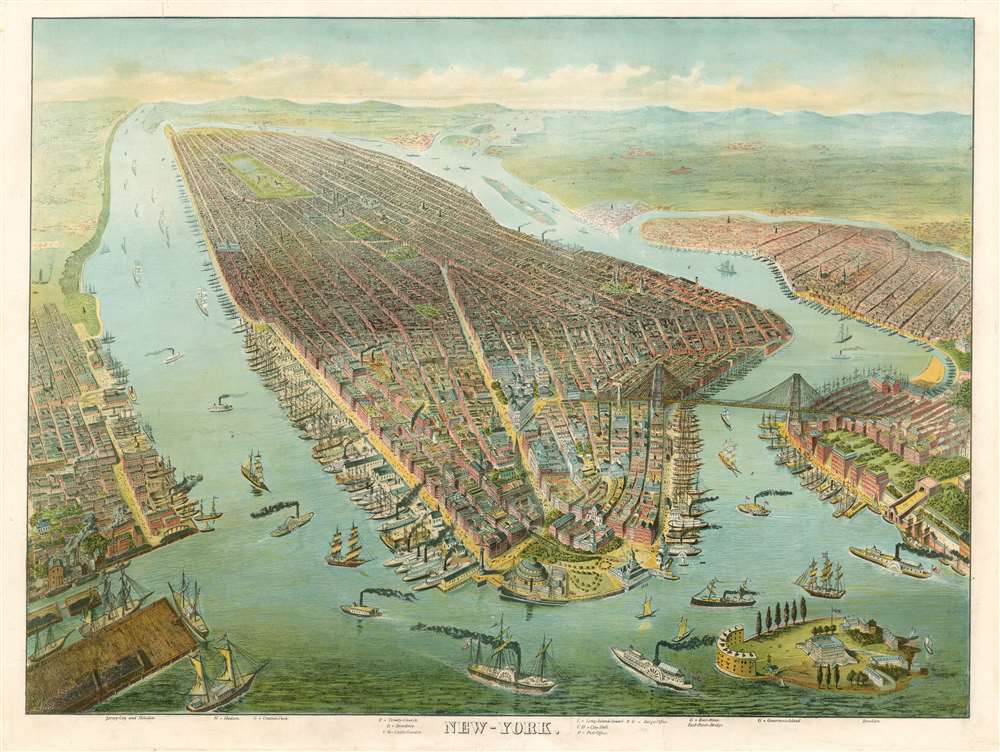This item has been sold, but you can get on the Waitlist to be notified if another example becomes available, or purchase a digital scan.
1898 Wachsmuth/ Molitor Bird's Eye View map of New York City
NewYork-molitor-1898
Title
1898 (undated) 24.25 x 32.25 in (61.595 x 81.915 cm)
Description
Castle Garden
Prominent in the foreground is Castle Garden, which between 1855 and 1890 was the primary immigrant processing center in the city until the 1892 opening of Ellis Island. Between 1896 and 1941 it was home to the New York City Aquarium, which is not indicated here: while this does not absolutely indicate a pre-1896 date for this view - indeed, Molitor did not begin work with Wachsmuth until 1898 - it certainly suggests that the source material originated prior to that change.Glimpses of the Growing Metropolitan Region
Though the view is dominated by Manhattan Island, to the left and right Hoboken, Jersey City and Brooklyn are shown with some precision. Both the Hudson and the East River teem with sailing ships and steamboats, emphasizing the nautical focus of the city.Chromolithography
Chromolithography is a color lithographic technique developed in the mid-19th century. The process involved using multiple lithographic stones, one for each color, to yield a rich composite effect. Oftentimes, the process would start with a black basecoat upon which subsequent colors were layered. Some chromolithographs used 30 or more separate lithographic stones to achieve the desired effect. Chromolithograph color could also be effectively blended for even more dramatic results. The process became extremely popular in the late 19th and early 20th centuries, when it emerged as the dominate method of color printing. The vivid color chromolithography produced made it exceptionally effective for advertising and propaganda imagery.Publication History and Census
This view, though not signed, is attributed to artist Mathieu Molitor, who produced educational wall maps and views of this type - known as Schulwandbilder or Charakterbilder - for educational publisher F. E. Wachsmuth. It does not appear to be catalogued in OCLC; views of this type survive their school environments poorly, and are consequently scarce on the market.CartographerS
Mathieu Molitor (May 23, 1873 - December 23, 1929) was a German Art Nouveau artist. His father, Johann Molitor, was a mine master; his youth was attended by moves all around Europe. He apprenticed in canal and railway construction, and between 1889 and 1892 was a surveyor, draftsman and construction clerk at the civil engineering office in Cologne. In that city he completed a further apprenticeship with the decorative painter L. Manza, later holding a managerial position in a Cologne painting business. There his first independent work emerged, among other things he created 12 ceiling paintings for the Cafe Maximilian in Cologne. In 1894 he studied at the Grand Ducal Saxon Art School in Weimar with Professor Max Thedy. In 1898 he relocated to Leipzig, and worked for the music publisher Breitkopf & Härtel and the school picture publisher FE Wachsmuth. His works are extremely diverse: he produced bronzes, landscape paintings, portraits, etchings, posters and bookplates. More by this mapmaker...
F. E. Wachsmuth (1870 - 1910) was a Leipzig printer primarily producing Schulwandbilder and Charakterbilder, large and colorful prints depicting different geographical regions, cultural activities and scenes meant for use in the classroom in support of lectures. Learn More...

